1996 PONTIAC GRAND-AM tow
[x] Cancel search: towPage 222 of 356
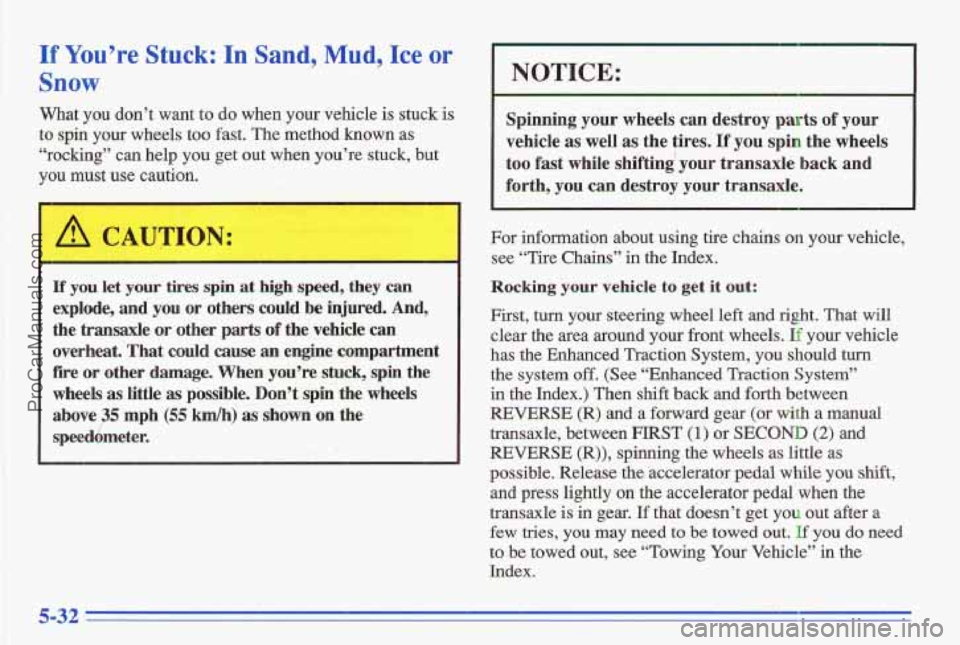
If You’re Stuck: In Sand,,Mud, Ice or
Snow
What you don’t want to do when your vehicle is stuck is
to spin your wheels too fast. The method known a,s
“rocking” can help you get out when you’re stuck, but
you must use caution.
/d CAUTION:
If you your .es spin at high speed, they can
explode, and you or others could be injured. And,
the tran,saxle or other parts of the vehicle can
overheat.
That could cause an engine compartment
fire or other damage. When you’re stuck, spin the
wheels
as little as possible. Don’t spin the wheels
above35 mph
(55 kdh) as shown on the
speedqmeter. Spinning
your wheels can destroy
parts of your
vehicle as well
as the tires. If you spin the wheels
too fast while shifting your transaxle back and
For information about using tire chains on your vehicle,
see “Tire Chains” in the Index.
Rocking y---r vehick ID get it out:
First, turn your steering wheel left and right. That will
clear the pea around your front wheels. If your vehicle
has the Enhanced Traction System, you should turn
the system
off. (See “Enhanced Traction System’’
in the Index.) Then shift back and forth between
REVERSE (R) and a forward gear
(or with a manual
transaxle, between FIRST
(1) or SECOND (2) and
REVERSE
(R)), spinning the wheels as little as
possible. Release the accelerator pedal
while you shift,
and press lightly on the accelerator pedal when the
transaxle is in gear.
If that doesn’t get you out after a
few tries, you may need to be towed out. If you do need
to be towe’d out, see “Towing Your Vehicle” in the
Index.
5-32
ProCarManuals.com
Page 233 of 356
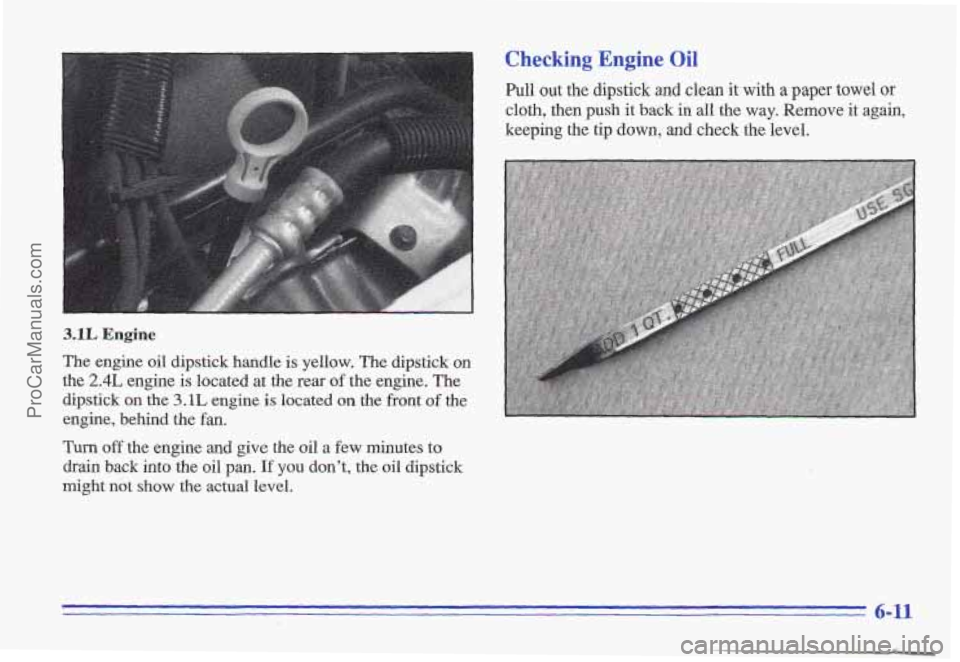
3.1L Engine
The engine oil dipstick handle is yellow. The dipstick on
the 2.4L engine is located at the rear of the engine. The
dipstick on
the 3.1L engine is located on the front of the
engine, behind the fan.
Turn off the engine and give the
oil a few minutes to
drain back into the oil pan.
If you don’t, the oil dipstick
might not show the actual level.
Checking Engine Oil
Pull out the dipstick and clean it with a paper towel or
cloth, then push it back in all the way. Remove it again,
keeping the tip down, and check the level.
6-11
I- ProCarManuals.com
Page 239 of 356
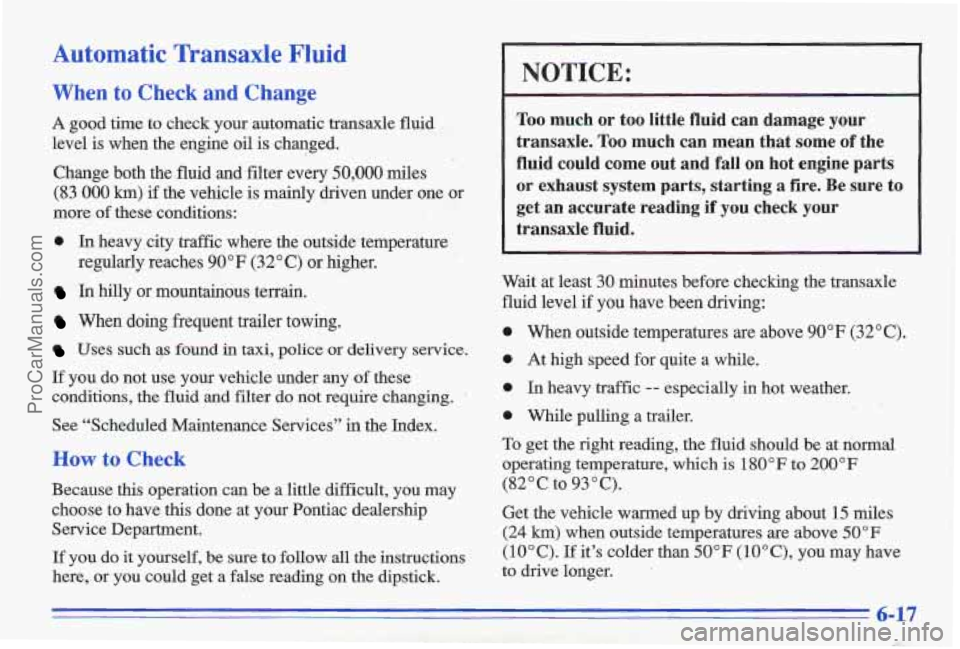
Automatic Transaxle Fluid
When to Check and Change
A good time to check your automatic transaxle fluid
level is when the engine oil is changed.
Change both the fluid and filter every
50,000 miles
(83 000 km) if the vehicle is mainly driven under one or
more of these conditions:
0 In heavy ,city traffic where the outside, temperature
In hilly or mountainous terrain.
When doing frequent trailer towing.
Uses such zp found in taxi, police or delivery service.
If you do not use your vehicle under any of these
conditions, the fluid and
filter do not require changing.
See “Scheduled Maintenance Services”
in the Index.
How to Check
Because this operation can be a little difficult, you may choose to have this done at your Pontiac dealership Service Department.
If you do it yourself, be sure to follow all the instructions
here, or
you could get a false reading on the dipstick.
regularly reaches
90°F (32°C)
or higher.
NOTICE:
Too much or too little fluid can damage your
transaxle.
Too much can mean that some of the
fluid could come out and fall on hot engine parts
or exhaust system parts, starting a fire. Be sure to
get an accurate reading if you check your
transaxle fluid.
Wait at least 30 minutes before checking the transaxle
fluid level
if you have been driving:
0 When outside temperatures are above 90°F (32°C).
0 At high speed for quite a while.
0 In heavy traffic -- especially in hot weather.
0 While pulling a trailer.
To get the right reading, the fluid should be at normal
operating temperature, which
is 180°F to 200°F
(82°C to 93°C).
Get the vehicle warmed up by driving about 15 miles
(24 krn) when outside temperatures are above 50°F
(10°C). If it’s colder than 50°F (lO°C), you may have
to drive longer.
ProCarManuals.com
Page 240 of 356
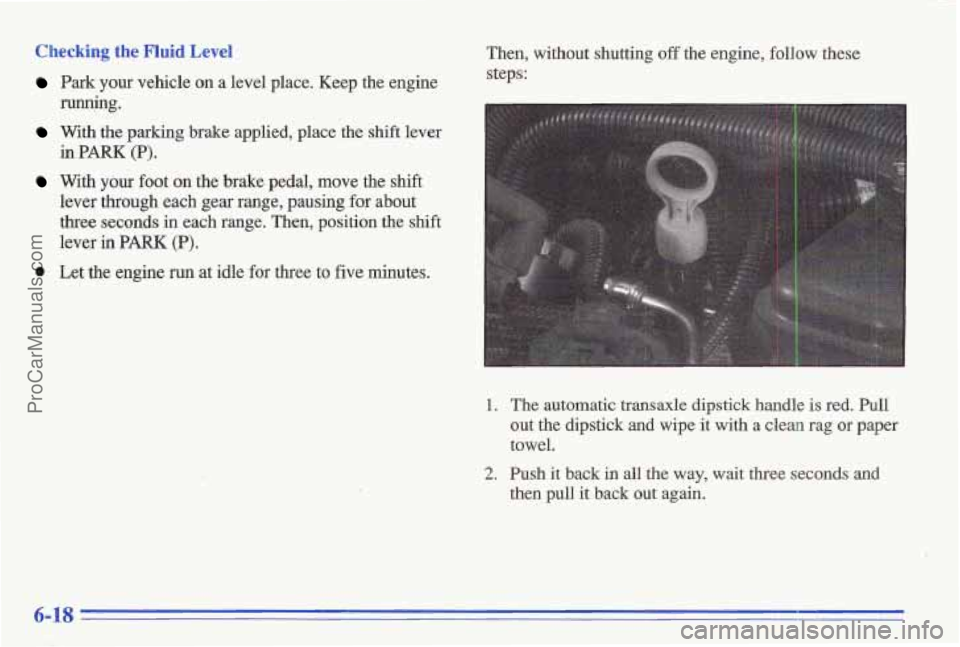
Checking the Fluid Level
' Park your vehicle on a level place. Keep the engine
running.
With the parking brake applied, place the shift lever
in
PARK (P). I
With your foot on the brake pedal, move the shift
lever through each
gear range, pausing for about
three seconds in each range. Then, position the shift
lever in PARK (P).
0 Let the engine run at idle for three to five minutes. Then,
without shutting
off the engine, follow these
steps:
1. The automatic transaxle dipstick handle is red. Pull
out the dipstick
and wipe it with a clean rag or paper
towel.
2. hsh it back in all the way, wait three seconds and
then pull it back out again.
6-18
ProCarManuals.com
Page 242 of 356
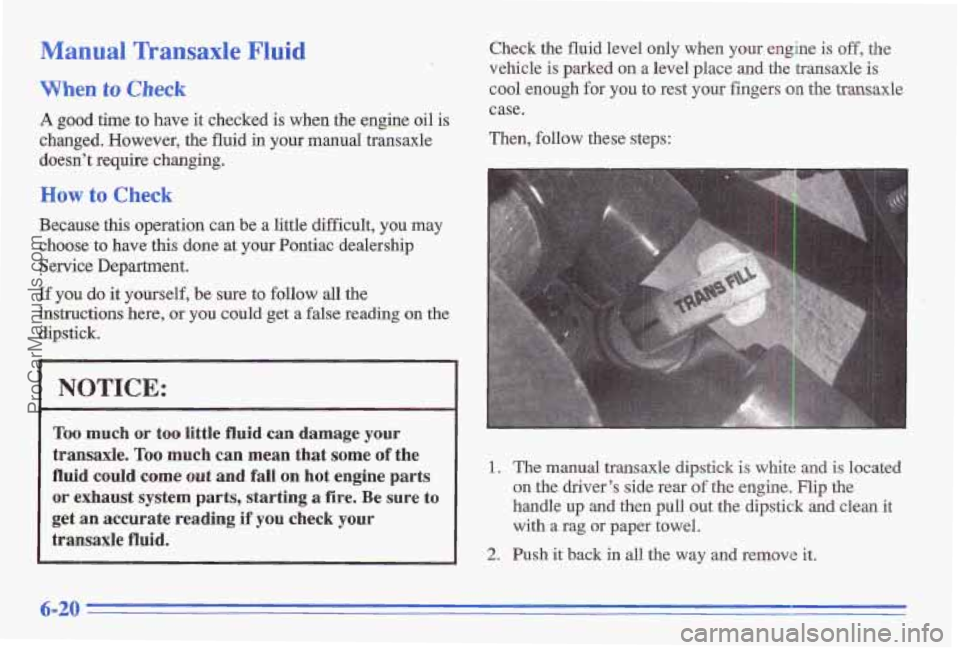
Manual Transaxle Fluid
When to Check
Check the fluid level only when your engine is off, the
vehicle
is parked on a level place and the transaxle is
cool enough for
you to rest your fingers on the tJransaxle
A good time to have it checked is when the engine oil. is
changed. However, the fluid in your manual transaxle Then, foll\
ow these steps:
doesn't require
changing.
case.
How to Check
Because this operation can b'e a little difficult, you may
choose to have this done at your Pontiac dealership
Service Department.
iG Jf you do it yourself, be sure to follow all the , .,..!%$i- k%4nstructions here, or you could get a false reading on the
,> , . ".
dipstick.
I
NOTICE:
Too much or too little fluid can damage your
transaxle. Too much can mean that some of the
fluid
could come out and fall on hot engine parts
or exhaust system parts, starting a fire. Be sure to
get an accurate reading if you check yuur
transaxle fluid.
1, The manual transaxle dipstick is white and is located
on the driver's side rear of the engine. Flip the
handle up and then pull out the dipstick and clean it
with a rag or paper towel.
2. Push it back in all the way and remove it.
6-20
ProCarManuals.com
Page 261 of 356

Tire Inspection and Rotation
Tires should be inspected every 6,000 to 8,000 miles
(10 000 to 13 000 km) for any signs of unusual wear.
If unusual wear is present, rotate your tires as soon as
possible and check wheel alignment. Also check for damaged tires or wheels. See “When It’s Time for New
Tires” and “Wheel Replacement” later in this section for
more information. When rotating your tires, always use the correct rotation
pattern shown here.
Don’t include
the compact.spa.re tire in your tire
rotation.
After the tires have been rotated, adjust the front and
rear inflation pressures as shown on the Tire-Loading
Information label. Make certain that all wheel nuts are
properly tightened. See “Wheel Nut Torque” in the
Index.
I
The purpose of regular rotation is to achieve more
uniforrn wear for all tires on the vehicle. The first
rotation is the most important. See “Scheduled Maintenance Services”
in the Index for scheduled
rotation intervals.
--
Rust or dirt on a wheel, lr on the part D which
it is fastened, can make wheel nuts become loose
after
a time. The wheel could come off and cause
an accident. When
you change a wheel, remove
any rust or- dirt from places where the wheel
attaches to the vehicle. In an emergency,
you can
use
a cloth or a paper towel to do this; but be
sure to use
a scraper or wire brush later, if you
need to, to get all the rust or dirt off. (See
“Changing
a Flat Tire” in the ‘Index.)
6-39
ProCarManuals.com
Page 268 of 356
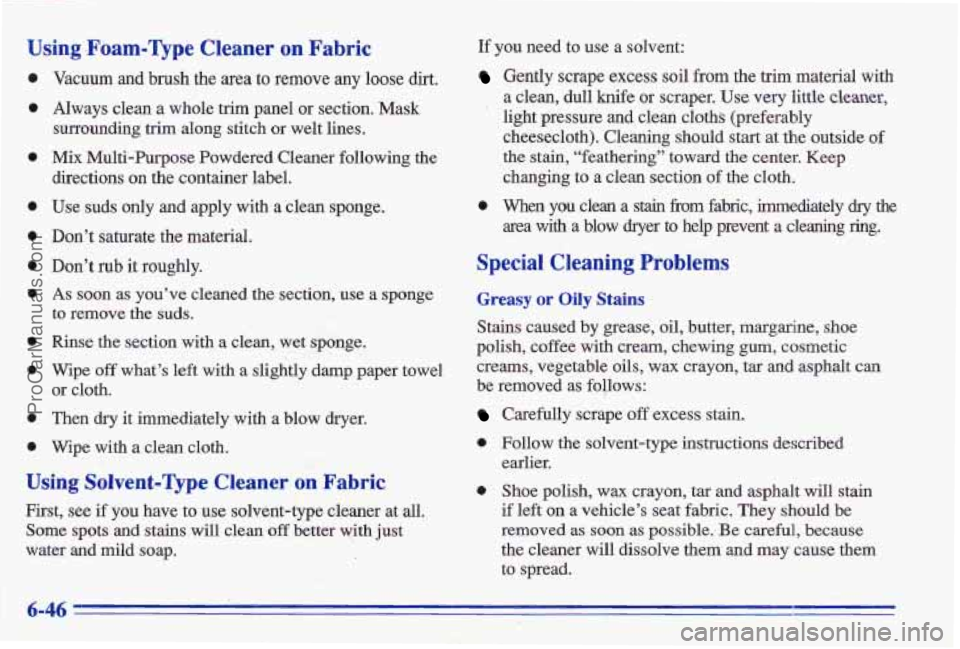
Using -Foam-Type Cleaner on Fabric
0
0
0
e
e
0
0
0
0
0
0
Vacuum and brush the area to remove any loose dirt.
Always clean a whole trim panel or section. Mask
surrounding
trim along stitch or welt lines.
Mix Multi-Purpose Powdered Cleaner following the
directions on the container label.
Use suds only and apply with a clean sponge.
Don’t saturate the material.
Don’t
rub it roughly.
As soon as you’ve cleaned the section, use a sponge
to remove the suds.
Rinse the section with
a clean, wet sponge.
Wipe
off what’s left with a slightly damp paper towel
or cloth.
Then dry it immediately with a blow dryer.
Wipe with a clean cloth.
Using Solvent-Type Cleaner on Fabric
First, see If you have to use solvent-type cleaner at all.
Some spots and stains will clean
off better vith just
water
and mild soap.
If you need to use a solvent:
Gently scrape excess soil from the ,trim material with
a clean, dull knife or scraper. Use
very little cleaner,
light pressure and clean cloths (preferably
cheesecloth). Cleaning should start at the outside
of
the stain, “feathering” toward the center. Keep
changing to a clean section
of the cloth.
0 when you clean a stain fi-om fabric, immediately dry the
area with a blow dryer to help prevent a cleaning ring.
-I
Special Cleaning Problems
Greasy or Oily Stains
Stains caused by grease, oil, butter, margarine, shoe
polish, coffee with cream, chewing gum, cosmetic creams, vegetable oils, wax crayon,
tar and asphalt can
be removed
as follows:
Carefully scrape off excess stain.
0 Follow the solvent-type instructions described
0 Shoe polish, wax crayon, tar and asphalt will stain
if left on a vehicle’s seat fabric. They should be
removed
as soon as pos,sible.,Be careful, because
the cleaner
will dissolve them and may cause them
to spread. earlier.
6-46
ProCarManuals.com
Page 271 of 356
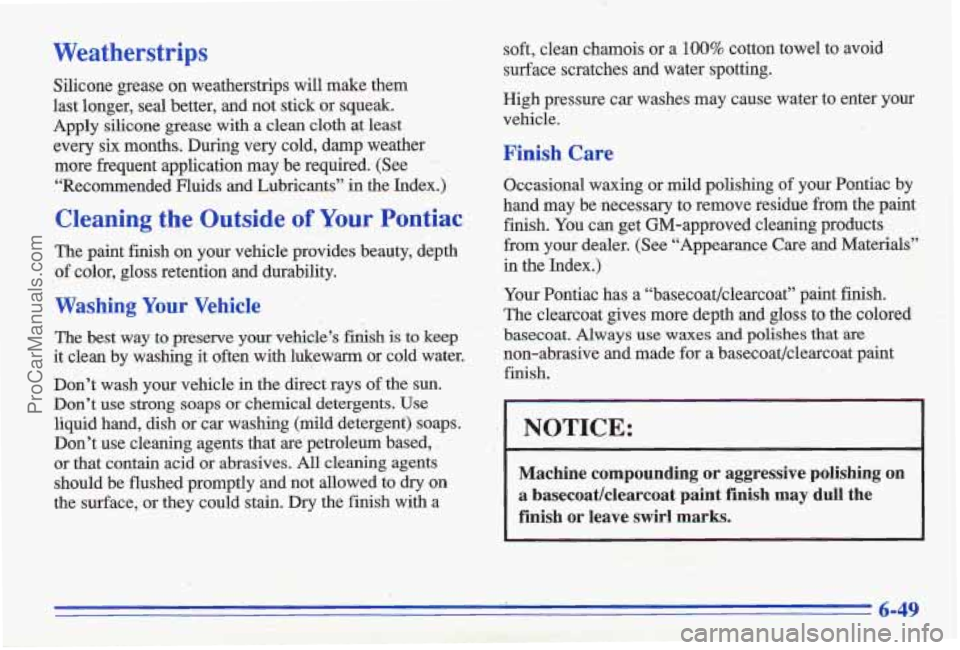
Weatherstrips
Silicone grease on weatherstrips will make them
last longer, seal better, and not stick
or squeak.
Apply silicone grease with a clean cloth at least
every six months. During very cold, damp weather more frequent application may be required. (See
“Recommended Fluids and Lubricants”, in the Index.)
-Cleaning the Outside of Your Pontiac
The paint finish on your vehicle provides beauty, depth
of color, gloss retention and durability.
Washing Your Vehicle .
The best way to preserve your vehicle’s fish is to keep
it clean by washing it often with lukewarm or cold water.
Don’t wash your vehicle in the directrays of the sun.
Don’t use strong soaps or chemical detergents. Use liquid hand, dish or-car washing (mild detergent) soaps.
Don’t use cleaning agents that are petroleum based,
or that contain acid or abrasives. All cleaning agents
should be flushed promptly and not allowed to
dry on
the surface,
or they could stain. Dry the finish with a soft, clean chamois or a
100% cotton towel to avoid
surface scratches and water spotting.
High pressure car washes may cause water to enter your
vehicle.
Finish Care
Occasional waxing or mild polishing of your Pontiac by
hand may beaecessary to remove residue from the paint
finish. You can get GM-approved cleaning products
from your dealer. (See “Appearance Care and Materials”
in the Index.)
Your Pontiac has
a “basecoat/clearcoat” paint finish.
The clearcoat gives more depth and gloss to the colored
basecoat. Always
use waxes and polishes that are
non-abrasive and made for
a basecoat/clearcoat paint
finish.
NOTICE:
Machine compounding or aggressive polishing on
a basecoat/clearcoat paint finish may dull the
finish
or leave swirl marks.
6-49
ProCarManuals.com